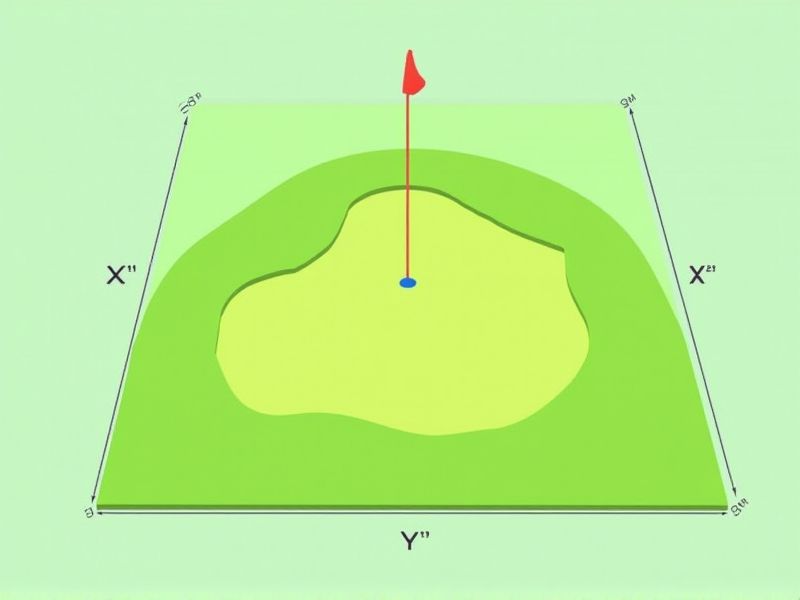
When designing or playing a golf course, understanding the standard dimensions of a golf hole is important for both strategy and course maintenance. Typically, a regulation golf hole has a diameter of 4.25 inches (108 mm) and must be at least 4 inches (101.6 mm) deep, according to the Rules of Golf set by The R&A and USGA. The length of individual holes varies greatly: par 3s are generally less than 250 yards, par 4s range from 251 to 470 yards, and par 5s are 471 yards or longer. Knowing these standard dimensions can help players better prepare for their game and guide course architects in meeting official regulations.
Tee Box
The tee box, typically 4 to 6 inches higher than the fairway, plays a crucial role in golf course design, influencing both player strategy and playability. It is usually marked with two sets of tee markers: the front tees for beginners and the back tees for advanced players, varying the distance to the hole between 200 to 450 yards. Each hole's tee box is specifically designed to optimize the golfer's experience, providing a clear sightline to the fairway and accommodating different skill levels. Ensuring that the tee boxes are well-maintained can enhance your overall enjoyment and performance on the course.
Fairway Length
The standard fairway length for a golf course typically ranges from 300 to 500 yards, depending on the skill level targeted. A well-maintained fairway should ideally be 30-40 yards wide, allowing enough space for players to land their drives accurately. Optimal grass types, such as Bentgrass or Bermuda, ensure a smooth surface, promoting consistent ball roll. Ensuring that fairway conditions remain pristine can significantly enhance your overall playing experience and course strategy.
Par Rating
A golf course's hole is categorized by its Par rating, which indicates the number of strokes an expert golfer is expected to take to complete that hole. Most holes are rated as Par 3, Par 4, or Par 5, with Par 3 holes averaging about 150 yards, Par 4 around 400 yards, and Par 5 typically exceeding 500 yards. Understanding the Par rating helps golfers strategize their approach, as it reflects the distance and difficulty presented by hazards and topography. Your performance against the Par rating can significantly affect your overall score and challenge as you navigate the course.
Green Dimensions
The standard dimensions for a golf course putting green typically range between 3,500 to 6,000 square feet, designed to enhance the playing experience. Greens are ideally shaped with a diameter of 12 to 15 feet for the cup area, ensuring a fair challenge for golfers. A slope of 1 to 2 percent is recommended to facilitate drainage and maintain healthy turf conditions. Investing time in understanding these dimensions can elevate your game by improving your approach and putting strategy.
Hazard Placement
Hazard placement on a golf course hole is critical for challenging players and enhancing the overall experience. Strategically located bunkers, water features, and rough areas can significantly impact shot selection, forcing golfers to think carefully about their approaches. For instance, placing a bunker 150 yards from the green can discourage aggressive play, encouraging layup strategies. Understanding these placements allows you to navigate the course more effectively, improving your game while enjoying the intricacies of course design.
Out-Of-Bounds Markers
Out-of-bounds markers in golf course design are essential for maintaining the integrity and pace of the game, typically placed at the edge of the playing area. These markers are often brightly colored, commonly white, to provide a clear visual indication of areas where play is prohibited. In standard golf course standards, the distance from the tee box to the nearest out-of-bounds marker can range from 5 to 15 yards, depending on the course layout and design. Understanding the positioning of these markers allows you to strategize your shots effectively and avoid penalties.
Rough Width
The rough width for golf course holes is typically standardized at around 4 to 6 feet, depending on the course design and difficulty level. A wider rough, measuring up to 8 feet, can increase the challenge for golfers by making recovery shots more difficult. Well-maintained roughs often feature a mix of grass species, enhancing playability while maintaining aesthetic appeal. Ultimately, this design element aims to balance difficulty and enjoyment, ensuring an engaging experience for players of all skill levels.
Dogleg Angle
The dogleg angle on a golf course hole is defined by the degree of deviation from a straight line between the tee and the green, often ranging from 30 to 90 degrees. This design element can significantly influence your strategy, as navigating the curve requires careful consideration of club selection and shot placement. Many dogleg holes demand precision off the tee to avoid hazards that may arise within that angled zone, encouraging players to assess risk versus reward. Understanding the specifics of a hole's dogleg angle can enhance your overall performance and enjoyment of the game.
Bunker Locations
Bunker locations on a golf course significantly impact playability and strategy, with around 5 to 10 strategically placed bunkers per hole in many championship courses. These sand traps typically cover 2% to 5% of the total course area, guiding golfers to approach shots carefully. Knowing the exact yardage to these bunkers, which can range from 20 to 100 yards from the green, is crucial for avoiding penalties and maintaining a lower score. Your understanding of bunker placement can enhance your overall game strategy, influencing club selection and shot execution.
Pin Position Variability
Pin position variability on a golf course significantly impacts playability and strategy, typically altering the difficulty of a hole. For instance, moving the pin to the back of a green may increase the challenge by requiring more precise distance control, while a front placement could tempt aggressive play. PGA Tour statistics indicate that pin position adjustments can affect scoring averages by as much as 1.5 strokes per round. Understanding these variances helps you assess risk-reward scenarios and devise better course management strategies during your round.
